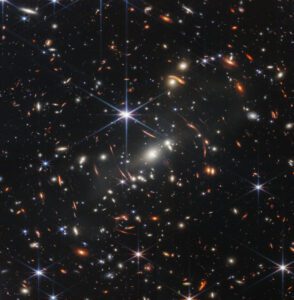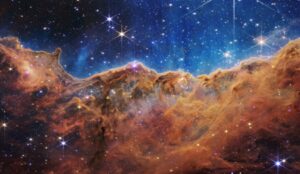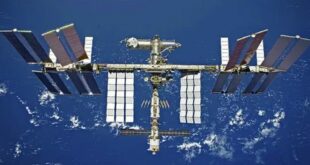By Andy Williams
Imagine walking on a remote beach away from the polluting lights of a city. You look up and see thousands upon thousands of stars blanketing the heavens, bisected by the pale glow of our Milky Way—the galactic disc in which we live. You pick up a grain of sand and hold it at arms’ length to cover a minuscule portion of the night sky. What might lie in that tiny patch?
The James Webb Space Telescope

We received the answer to this question on 11th July, 2022, when the President of the United States of America, Joe Biden, unveiled the first image from the James Webb Space Telescope (JWST). The image is the deepest and sharpest image in infrared light of the distant Universe, covering a cluster of galaxies known as SMACS 0723. JWST gazed at this tiny spot for twelve hours, collecting photons that have travelled for billions of years from the early dawn of the Universe, revealing a tapestry of distant stars and ancient galaxies, some spectacularly distorted by the effects of gravitational lensing.
The next day, humanity was awed with the further images and spectra from this technological marvel: the tell-tale fingerprint of water, clouds and hazes from WASP-96b—a gas-giant planet orbiting close to its star over 1,000 light years away; and visually stunning images of nebula and galaxies, made special by JWST’s high spatial resolution and powerful infrared vision.
As a result of the European Space Agency’s high precision launch from an Ariane 5 rocket on Christmas Day, 2021, JWST was gifted extra propellant and therefore extra lifetime. Astronomers are expecting amazing scientific findings from the hopefully two decades’ lifespan of the observatory, organised around the themes of four science cases: the early Universe, galaxies over time, the lifecycles of stars, and other worlds. JWST will look back in time with its infrared vision and observe ancient galaxies, but also study atmospheres of exoplanets in other solar systems and search for the building blocks or even signs of life. In addition to peering beyond our own galaxy and solar system, JWST will allow exploration closer to home, where scientists plan an extensive range of observations of planets, moons, comets and asteroids in our own planetary neighborhood. What is potentially more exciting is the unexpected and unplanned discoveries that were not anticipated in the original science case.
Over 300 organisations, research institutes and companies from multiple countries participated in the development of JWST.
In its final orbit around the second Lagrange point over 1.5 million kilometres from Earth, JWST is spectacularly distant from its creators. The observatory will not operate unaccompanied, however, acting in synergy with other space-based and ground-based telescopes. The ability to maximise complimentary capabilities and observations between instruments features heavily in their conception and design. When the next generation of mega-science projects such as European Southern Observatory’s Extremely Large Telescope and the Square Kilometre Array Observatory come online in the next decade, astronomers will have an unprecedented suite of tools to study the Universe.
The societal benefits of astronomy
In 1989, when Space Telescope Science Institute director and soon-to-be ESO Director-General, Ricardo Giaconni, instructed the community to start thinking about the next mission beyond Hubble, the existence of planets around other stars was only a hypothesis. Now more than 5,000 “exoplanets” have been confirmed through direct or indirect observations. While JWST and other observatories will unlikely see planets outside our own galaxy, let alone immediate solar neighborhood, we can estimate reliably that most stars have one or more planets. There are between 150-400 billion stars in our galaxy and therefore a comparable number of exoplanets. Now extrapolate this to all the galaxies found in the JWST first image in just one tiny patch of the sky and then fill in the entire sky with galaxy-saturated sand grains: our Universe is literally teeming with planets.

But what is the value of this knowledge, aside from the cumulative technological progress in telescopes that made the discovery of exoplanets possible? Perhaps the greatest quest of humankind is to know if other life exists elsewhere in our Universe, indeed, the next generation of astronomical observatories in ground and in space is approaching the ability to answer this question. The effects of such a discovery on our society would be profound and would certainly generate unprecedented public interest in science. Even if evidence of life is not forthcoming, school children in future decades will learn about the nature of planets orbiting other stars with the same familiarity and acceptance of the existence of the planets and moons of our own star system, and will hopefully gain an appreciation of the vastness of the cosmos.
Another major recent revelation of astronomy is that we do not understand the basic constituents of the Universe. Astronomical observations suggest the existence of some unknown “dark matter” that affects large scale structure of the Universe and motion of galaxies, and an even more mysterious “dark energy” that is causing the Universe to expand increasingly faster. The same issue dominates the science of particle physics, which looks at the smallest scales in the Universe. The discovery of the Higgs Boson particle at CERN was the final piece in the puzzle of the “standard model”—an outstandingly successful theory explaining all the normal matter encountered thus far. Yet this framework does not include gravity and leaves no room for dark matter or energy. There are tantalizing hints that our conception of reality is a subtle mirage. Scientists using JWST and other telescopes such as the forthcoming Roman Space Telescope look to understand the vast structure of the cosmos and infer the constituents of all matter and forces.
With such seemingly esoteric topics so far removed from the daily struggles of peoples’ lives, it is certainly appropriate to ask if this endeavour is worthwhile? Before these amazing images captured the world’s attention, filled the media space and even adorned the Google search page, JWST was better known for its substantial cost overruns, near cancellation, and eye wateringly high 10 Billion dollar price tag. As the institutions and facilities that support fundamental scientific research are typically publicly funded, it is right that we are called to justify our broader value and convince politicians and ultimately the public that our endeavours are worthwhile.
We often frame our value in economic terms, showing that investment in fundamental science can be justified as a key driver for an economy’s growth and productivity. Both NASA and ESA have conducted impact assessments and found strong economic multipliers from investment in space science. Over 300 organisations, research institutes and companies from multiple countries participated in the development of JWST. The project funded thousands of high-tech jobs over two decades, planting seeds of ideas in the minds of these scientists and engineers that may one day result in unexpected technological breakthroughs. We may also point to the multiple technological spinoffs associated with investment in research infrastructures, or knowledge transfer to industry. The inspirational nature of astronomy and the pursuit of fundamental science and exploration are often touted as key stimulators of interest in STEM careers and indeed the space sector in general. The fact that most space companies publicised the JWST releases as enthusiastically (or perhaps more so) than their own missions demonstrates this inspirational drive of astronomy.
Our best selves
These important economic and social impact arguments are necessary to ensure that we are continually optimising our facilities and seeking value for the taxpayer, yet the justification of fundamental curiosity-driven research by its by-products risks devaluing its intrinsic purpose: providing a legacy of knowledge bestowed to future generations. We must also not forget the value of the process of the whole endeavour. The development and use of JWST and other large scientific enterprises marshal and sustain vast international collaborations of scientists and engineers for inherently peaceful purposes. We must recognise the strategic benefits of this peaceful pursuit for humanity and the value of curiosity about our Universe. In this increasingly science-sceptical age, this value is worth upholding. Yet the world faces far broader challenges of climate change, war and economics. Now more than ever we need to invest our best selves. JWST is a shining example of our best and proudest moments.

Andy Williams is responsible for external relations at the European Southern Observatory (ESO) – an intergovernmental organisation of 16 Member States that constructs and operates world-leading astronomical facilities and fosters international cooperation. Dr Williams supports strategic relationships with current and future Member States, the EU, UN, and international organisations such as the ESA and CERN. He represents ESO at the UN Committee on the Peaceful Uses of Outer Space, and recently has been dealing with the policy aspects of the impact of satellite constellations on astronomy as a broader aspect of space sustainability. He serves as ESO’s representative on the Executive Board of ATTRACT – a 55 Million Euro project to create a breakthrough technology innovation process using Big Science research facilities. He has a degree in theoretical physics and a doctorate in public policy.
 SpaceWatch.Global An independent perspective on space
SpaceWatch.Global An independent perspective on space




